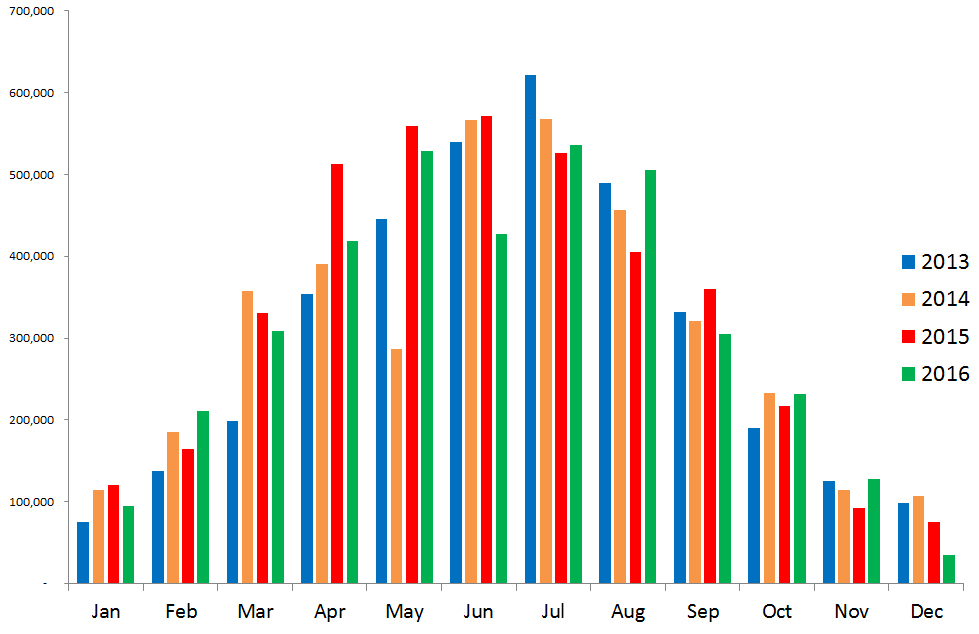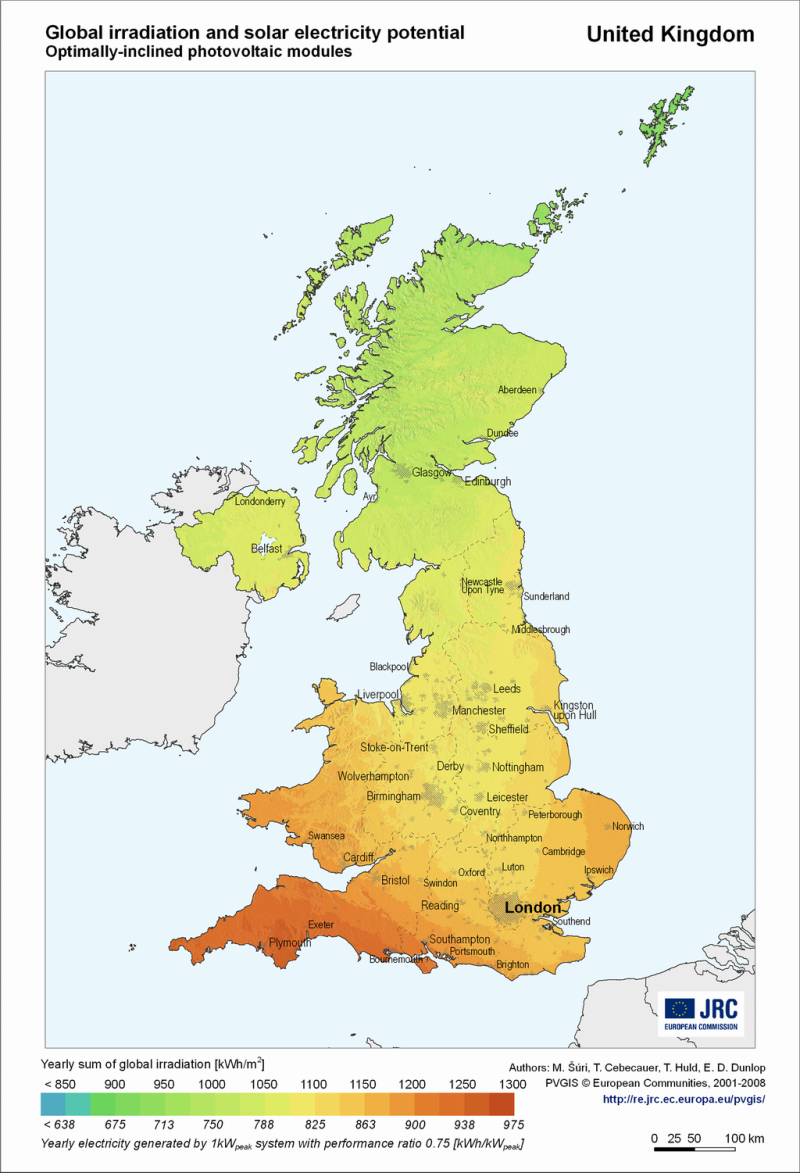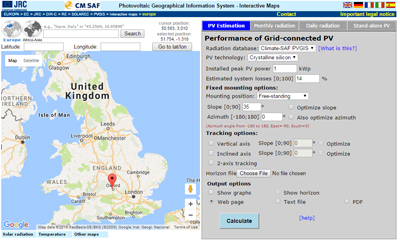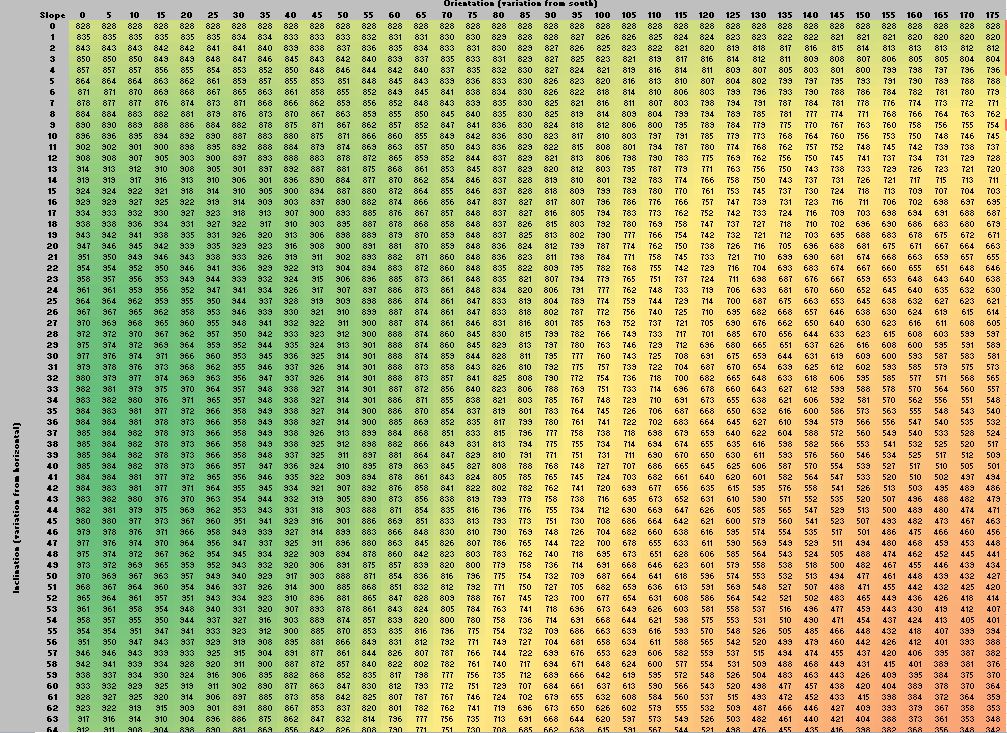Solar Panel Energy Output
How to calculate the annual energy yield from your solar pv panels

Annual yield from a solar panel system is the amount of electrical energy that your solar panels will generate over a 12 month period – this is normally measured in kWh.
Are you thinking about installing solar panels and want to know how much energy they will generate? Or do you have solar panels installed and want to try and work out if your panels are generating correctly? If so then this article should help you. below we will look what annual yield is, why it is important and what are the factors that affect it. We will also look at various ways of estimating how much energy your solar panel system should generate and share some useful resources and tools that you can use to make predictions about the annual energy production from your solar panels.
Contents
-
Why is calculating the annual yield from your solar panels important?
-
What factors affect the annual yield from a solar panel system?
-
What are the primary ways of calculating energy output?
-
MCS Installers Standard Estimation Method
-
Energy Saving Trust Website tool
-
PV GIS
-
Free estimation software provided by inverter manufacturers
-
Specialist solar pv industry design software
-
A few words about terminology:
Unfortunately there are lots of phrases that are used to describe the electrical energy generated by a solar panel system over a year.
- Solar Panel Output
- Solar Panel Yield
- Average Annual Yield
- Total annual energy generation
- Annual Energy Generation Estimate
- Estimated Energy generated per year
- Annual AC Output
You get the idea! When talking about an estimate of how much electrical energy your system will generate over a year these basically all mean the same thing. The point is to be aware of the different terminology and make sure you know exactly what they mean by it.
Annual yield from a solar panel system is the amount of electrical energy that your solar panels will generate over a 12 month period.
This electrical energy generated by the panels could be self-consumed in your property, stored in a battery system for use later on or exported to the national grid. Electrical energy (eg the electrical energy generated by the solar panels) is usually measured in kilowatt-hours, often displayed as kWh, and sometimes described as ‘units’.
A very rough rule of thumb – for the UK
Before we get into the detail of the article below I will show you a very rough rule of thumb that can be used to calculate how much energy your system will generate. This is a very approximate method but it will save you reading the rest of the article if you need to work something out quickly. All you need to know is a size for the solar panel system and a location. We make the following assumptions:
- The solar panels are unshaded
- The solar panel s are at an angle from the horizontal of 35 degrees – most pitched roofs in the UK are similar to this
- The solar panels are facing south
- The panels are in the UK
If all of these are true we can use a factor to quickly work out the annual yield. This factor is kWh/kWp and is called the kK factor.
The calculation is this:
Annual Solar Panel Energy Output (in kWh) = kK x system kWp
A rough kK value you can use for most of the UK is:
950 kWh/kWp per year
So say we have a 4 kWp solar panel system we estimate that the annual output will be:
Energy Output = kK x kWp
= 950 x 4
= 3,800 kWh
A couple of rough rules of thumb:
If facing SE or SW you can apply a 95% factor
If facing E or W you can apply a 80% factor
This kK factor will change in different parts of the UK:
|
Location in the UK |
kK factor |
|
Land’s End |
1091 |
|
Oxford |
984 |
|
Birmingham |
935 |
|
Edinburgh |
902 |
Remember if the panels are shaded, are at a different pitch or are facing a different direction to the above assumptions then the kK value will be different. The combination of all of these factors has the potential to be significant.
Why is calculating the annual yield from your solar panels important?
 There are a number of reasons it is useful to have an idea of how much electrical energy will be generated by the solar panel system:
There are a number of reasons it is useful to have an idea of how much electrical energy will be generated by the solar panel system:
-
you can use this figure to work out how much money you may be able to earn through the feed-in tariffs
-
combined with information on your energy consumption you can use it to make an estimate of how much energy you might be able to save by installing solar panels
-
combined with the total cost of the solar pv system you can work out the likely return on investment and payback periods
-
you can compare the output from different systems, eg putting panels on different roof areas or using different sized solar panels
-
knowing how the annual energy estimate is calculated also means you can check solar panel installers quotations for accuracy
-
having an idea of how much energy your system generates will mean you will notice if the system starts to develop some sort of issue that impairs the system performance
What factors affect the annual yield from a solar panel system?
There are a number of key factors that will have an impact on your system output:
- System size in kWp
- How much solar energy there is available at the location of the solar panel – for example a system in Spain is going to generate more electricity that one in Scotland!
- The pitch - The angle of the panels from the horizontal
- The azimuth - The angle of the panels from south
- Any shading issues for example from nearby trees or houses
There are other factors which are discussed further on in this article but these five are the most significant. When looking at a roof mounted solar panel system most of the factors above will be constrained by the building we are mounting onto and any neighbouring buildings or nearby trees.
The table below shows the effects of azimuth (degrees from south) and pitch (degrees from horizontal) on the output of the solar array. The table is using solar data for Oxford but will be pretty similar for most locations in the UK. As you move to further North or South the figures will change a little.
| Azimouth - Degrees from South | |||||||||
| North West | West | South West | South | South East | East | North East | |||
| 135° | 90° | 45° | 0° | 45° | 90° | 135° | |||
| Pitch - Degrees from Horizontal | 0° | 82% | 82% | 82% | 82% | 82% | 82% | 82% | |
| 30° | 64% | 79% | 93% | 99% | 93% | 79% | 64% | ||
| 45° | 56% | 76% | 93% | 100% | 93% | 76% | 56% | ||
| 60° | 49% | 69% | 89% | 96% | 89% | 69% | 49% | ||
| 90° | 32% | 51% | 68% | 74% | 68% | 51% | 32% | ||
Compariative differences in solar yeild with solar panels mounted at different angles from south and angles from the horizontal
Other factors that have an impact on system performance
Other factors that can make a difference to the annual yield of a solar panel system are:
Solar panel performance – not all panels will perform the same. However the difference here should be pretty minimal and is pretty difficult to take into account with any accuracy. The best policy is to use a trusted, established solar panel brand with a reputation for quality.
Inverter type – Whether the system uses a string inverter, micro-inverters or power optimisers will all make a difference. This difference becomes more pronounced when the system suffers from shading. Using advanced solar sizing software can help calculate this with accuracy.
Inverter performance and efficiency – Not all solar inverters will perform the same.
Panel-Inverter mismatching issues, e.g. clipping of peak solar production by a smaller inverter
Overall system performance and efficiency – e.g. losses from cable runs
Local grid disruptions
System downtime (e.g. due to system fault)
Solar panel degradation – this will happen over time but hopefully will be minimal
Local environmental conditions – is there plenty of air-flow under the panels to help keep them cool? Is the inverter mounted in a hot loft or a cool garage? These are factors that could make differences to overall system performance.
Quality of the solar panel installation work and installer – If you don’t choose a quality solar panel installation company you could potentially loose production due to mistakes with installation work. One quick example: I have visited people who have had solar panels installed for years who did not realise that only half of their solar panels were plugged in!
Some of these factors are too tricky to take into account properly and the differences are probably negligible. Others can be kept to a minimum by a well-designed solar panel using high quality equipment and experienced solar panel installers.
What are the primary ways of calculating energy output?
We have already showed the rule of thumb of using the kK value of 950 kWh/kWp. There are a number of ways we can improve on this crude estimate technique. Some of these are:
-
MCS Installers Standard Estimation Method
-
Energy Saving Trust Website
-
PV GIS
-
Free estimation software provided by inverter manufacturers
-
Specialist solar pv industry design software
MCS Installers Standard Estimation Method
This is a method set out by the Microgeneration Certification Scheme guidelines that all solar panel installers have to use to illustrate likely solar panel output to potential customers in quotations and proposals. The idea is that if you are looking at two quotes from different solar panel installers, and they are both installing the same sized system on the same roof area, providing they have both followed the method correctly there should be no difference between the two estimates.
The calculation that is used in the Standard Estimation Method is as follows:
Annual output (kWh) = kWp x Kk x SF
kWp is the size of the solar pv array
kK is a factor based on location in the country, angle of the solar panels from the horizontal and angle of the panels from south
SF is a shading factor estimated based on shading issues affecting the panels.
During a site survey a solar panel surveyor will assess:
-
The location of the array in the country (postcode location)
-
The pitch of the array – often the angle of the roof
-
The orientation of the array from south
-
Any shading issues will be measured using a shading analysis tool – This will result in a shading factor (SF)
-
The available area for the solar panels – this will often dictate the size of the array (kWp)
Using the first three factors the installer work out the kK value for the specific installation from a location specific table similar to this one which is used for the OX postcode:
Then using the system size in kWp, the kK value and the Shading Factor (SF) the annual energy generation can be estimated.
I have used this method for a number of years and, providing it is done properly, it is an accurate way of estimating the amount of energy generated by a solar panel system.
Energy Saving Trust Website tool
The Energy Saving Trust is an independent Government supported website that helps to educate and inform consumers about energy efficiency and renewable energy. It is a great resource of impartial and straightforward information. They have an online calculator tool uses a very similar (but not identical) methodology to the Standard Estimation Method detailed above. The Energy Saving Trust website states:
“For the avoidance of doubt, the results in this calculator are not exactly the same as those estimated by the Standard Estimation Method which is used by MCS certified installers in solar PV quotations. The methodology used in this calculator is based on the Government's Standard Assessment Procedure (SAP) 2012 which uses different assumptions for the average level of solar radiation in an area.”
The result will be very similar though and an easy tool to use if you want to work out your likely energy generation from a trusted, independent website.
http://www.pvfitcalculator.energysavingtrust.org.uk/
PV GIS
 PV GIS or Photovoltaic Geographic Information System is a European website providing a map-based online calculator for estimating the annual yield for solar panel systems anywhere in Europe, Africa and Asia. It provides graphs of performance which can be exported as a webpage, a pdf or as a .txt document which can be imported in excel for separate analysis. It also has data on monthly and daily radiation and a calculator for off-grid (stand-alone) solar pv systems. You can also import a horizon file to take into account any shading caused by the horizon or surrounding buildings or trees. It is a bit more difficult to use than the Energy Saving Trust tool but it does allow you to control more variables, has more detailed output and also has data for the whole of Europe.
PV GIS or Photovoltaic Geographic Information System is a European website providing a map-based online calculator for estimating the annual yield for solar panel systems anywhere in Europe, Africa and Asia. It provides graphs of performance which can be exported as a webpage, a pdf or as a .txt document which can be imported in excel for separate analysis. It also has data on monthly and daily radiation and a calculator for off-grid (stand-alone) solar pv systems. You can also import a horizon file to take into account any shading caused by the horizon or surrounding buildings or trees. It is a bit more difficult to use than the Energy Saving Trust tool but it does allow you to control more variables, has more detailed output and also has data for the whole of Europe.
http://re.jrc.ec.europa.eu/pvgis/
Free estimation software provided by inverter manufacturers
Almost all inverter manufacturers provide free software, sometime online or sometimes to download that provides energy estimate calculations for their systems based on specific solar panel choice. Again you have to specify all of the other parameters like location, pitch and orientation to make sure you get an accurate reading. These tend to be fairly basic software packages that are more concerned with matching solar panel string voltages with allowable inverter voltage levels in order to design a system that will perform well. They do not always take into account shading factors and so if you do suffer from shading issue the estimates presented could be misleading.
A couple of software packages can be found here:
http://www.sunnydesignweb.com/sdweb/
http://www.solaredge.com/products/installer-tools/site-designer#/
Specialist solar pv industry design software
There are a few specialist solar pv industry software packages which allow a more detailed analysis of likely system performance. These often include 3D CAD packages that allow you to simulate the local buildings and trees. It also allows you to assess many different design options quickly and easily showing different solar panel and inverter combinations and their likely outputs.
Specialist solar pv design software are particularly good if:
-
There are complex shading issues that can be computed
-
You need to optimise panel positioning because of shading issues
-
You need to quickly get an idea of performance for lots of different solar panels and inverter combinations
The main downsides with these software packages are that they are costly and they require some specialist knowledge to get the best out of them.
Summary
There are lots of different ways of estimating how much energy your solar panels will, or should be generating. Assuming you have a roof-mounted, unshaded, south facing array in the UK a quick rule of thumb is 950 x the array size in kWp. All solar panel installers should be using exactly the same methodology (MCS Installers Standard Estimation Method)so that comparing quotes between installers is easy to do. There are a number of useful online resources like GIS and the Energy Savings Trust that will help you work out the likely estimate independently. If you have complex shading or other design considerations it may make sense to use more advanced solar pv specialist design software to work out you likely solar panel yield.
If you have any questions or queries about any of the above please don’t hesitate to get in touch with Exeo Energy.
References and links:
Guide to the Installation of Photovoltaic Systems, 2012
Accessed from MCS website on 12/11/2016
http://www.microgenerationcertification.org/mcs-standards/installer-standards/solar-pv
Energy Saving Trust PV Calculator
http://www.pvfitcalculator.energysavingtrust.org.uk/
PV GIS Website
http://re.jrc.ec.europa.eu/pvgis/
SMA Sunny Design Software
http://www.sunnydesignweb.com/sdweb/
Solar Edge Design Software
http://www.solaredge.com/products/installer-tools/site-designer#/


